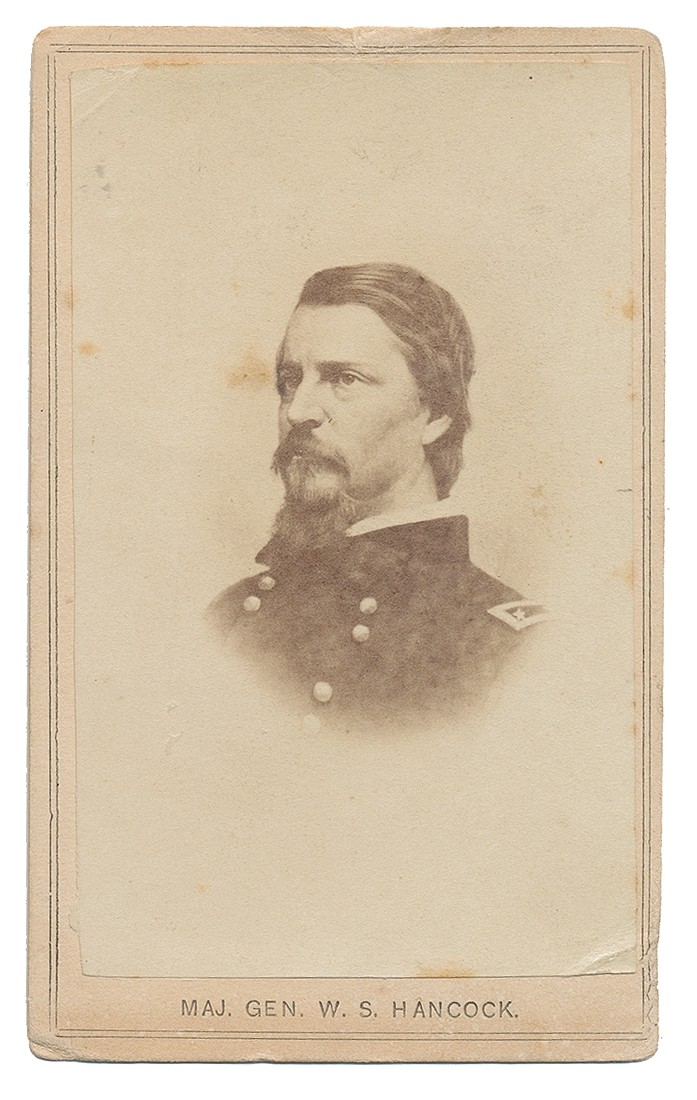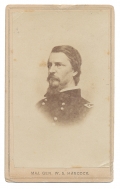site search
online catalog
LITHOGRAPH CDV OF UNION MAJOR GENERAL WINFIELD SCOTT HANCOCK

$45.00 SOLD
Quantity Available: None
Item Code: 2020-760
Bust image lithograph shows Hancock in the uniform of a major general.
Mount has light edge wear while the paper has light scattered foxing. Bottom center of the mount has a printed caption “MAJ. GEN. W. S. HANCOCK.”
Reverse is blank.
Hancock graduated from West Point in 1844. He served in the Mexican War and was honored for his bravery at the battle of Churubusco. When the Civil War began he was serving at Los Angeles, struggling to keep Union ammunition from Southern sympathizers. He was assigned to be General Robert Anderson’s quartermaster in Kentucky. Thankfully for the Union, Gen. McClellan recognized Hancock’s potential and made him a Brigadier General in William “Baldy” Smith’s Division.
On May 5, 1862, Hancock took the initiative in the Battle of Williamsburg and occupied two abandoned redoubts. His reputation skyrocketed because of this battle. During the Battle of Antietam, Hancock was ordered to command mortally wounded Gen. Israel Richardson’s division at the sunken Road. In November he was promoted to Major General.
At Chancellorsville, May 1-3, 1863; Hancock’s division was the last on the field, holding on long enough for the Federals to withdraw. General Darius Couch, commander of the Union Second Corps, had been extremely disgusted with the performance of Gen. “Fighting Joe” Hooker. Couch left the corps and Hancock became its new commander. By the July 1-3, 1863 Battle of Gettysburg, George Gordon Meade was the new commanding general. After learning that the armies were engaged at Gettysburg and Gen. John Reynolds was killed, Meade sent Hancock to act on his behalf and decide if it was a good battle position. On July 2nd Hancock helped fix Gen. Daniel Sickle’s blunder at the Peach Orchard, he also sent the 1st Minnesota to halt Gen. A.P. Hill’s corps at Cemetery Ridge. On the 3rd, his men helped beat back “Pickett’s Charge” Hancock was seriously wounded in the thigh during the battle.
By the time Hancock rejoined the Second Corps in March, Ulysses S. Grant was the commander of all Union forces. Even though the Federals lost the Battle of the Wilderness on May 5-7, 1864 they did not retreat. Hancock’s Second Corps attacked A.P. Hill’s corps at the Plank Road, driving the Confederates back in confusion. Gen. James Longstreet’s arrival prevented the Confederate right flank from collapsing.
At Spotsylvania Courthouse, Hancock’s men successfully attacked the “Mule Shoe Salient” on May 12, 1864 and captured approximately 2800 prisoners. Hancock’s men also took part in the infamous June 3rd attacks at Cold Harbor, in which thousands of men were lost in minutes. By June 10th, his Gettysburg wound had left him immobilized. A tremendous opportunity was lost at Petersburg, July 15-18, 1864. On June 15th, General “Baldy” Smith’s forces defeated a small Confederate force three miles east of the primary defensive line. Had Hancock taken command as the ranking officer, and ordered another charge, Union forces might have prevailed.
On July 27th, Hancock’s Second Corps coordinated with Philip Sheridan’s cavalry, crossing north of the James River at Deep Bottom in an attempt to sever the railroad lines linking Lee and Jubal Early (in the Shenandoah Valley). He fell short of his goal, breaking only the outer Confederate lines. There was a second fight at Deep Bottom; however, due to the heat and the high number of new recruits, the battle was lost. This loss was followed by a humiliating defeat at Reams Station, August 24, 1864. Hancock’s adjutant recalled that “the agony of that day never passed away from the proud soldier.” At Burgess Mill, October 27-28, 1864, the Second Corps performed well, but gained and then lost the Boydton Plank Road. This was Hancock’s last battle. He went on to head the Department of West Virginia until war’s end, and also organized the 1st Veterans Corp.
After the assassination of Abraham Lincoln, Hancock received criticism for his role in the execution of Mary Surratt, one of the conspirators. He did not want Surratt to be executed. He also received criticism while commander of the Fifth Military District during Reconstruction. He had issued “General Orders No. 40”, declaring that a state of peace existed in the district so he would not interfere with civil authorities. This also meant that no soldiers would appear at polling places.
When Ulysses S. Grant was inaugurated as the 18th president, Hancock was sent to the Department of Dakota. When George Meade died in November 1872, Hancock became the new Commander of the Division of the Atlantic, a position he held for the rest of his life. In 1880, Hancock was the Democratic presidential candidate. He was defeated by James A. Garfield. On February 9th 1886, Winfield Hancock died due to complications from diabetes. He was laid to rest at Norristown, PA. [ad]
~~~~~~~~~~~~~~~~~~~~~~~~~~~~~~~~~~~
THIS ITEM, AS WITH ALL OTHER ITEMS AVAILABLE ON OUR WEB SITE,
MAY BE PURCHASED THROUGH OUR LAYAWAY PROGRAM.
FOR OUR POLICIES AND TERMS,
CLICK ON ‘CONTACT US’ AT THE TOP OF ANY PAGE ON THE SITE,
THEN ON ‘LAYAWAY POLICY’.
THANK YOU!
Inquire About LITHOGRAPH CDV OF UNION MAJOR GENERAL WINFIELD SCOTT HANCOCK
For inquiries, please email us at [email protected]
Most Popular
Historical Firearms Stolen From The National Civil War Museum In Harrisburg, Pa »
Theft From Gravesite Of Gen. John Reynolds »
Selection Of Unframed Prints By Don Troiani »
Fine Condition Brass Infantry Bugle Insignia »
Wonderful Condition Original Confederate-Manufactured Kepi For A Drummer Boy Or Child »
featured item
CIVIL WAR IMPORT AUSTRIAN/PIEDMONT-SARDINIA/LIEGE MUSKETOON
This nice looking imported musketoon likely arrived in the U.S. courtesy of American purchasing agents scouring Europe for arms in 1861 and 1862. This is smoothbore, .70 caliber, with an overall length of 41 inches and a barrel measuring 27 7/8… (998-27). Learn More »
site search
Upcoming Events
The shop is closed Jan. 2nd thru Jan. 16th for inventory; we will still be available by phone &… Learn More »



